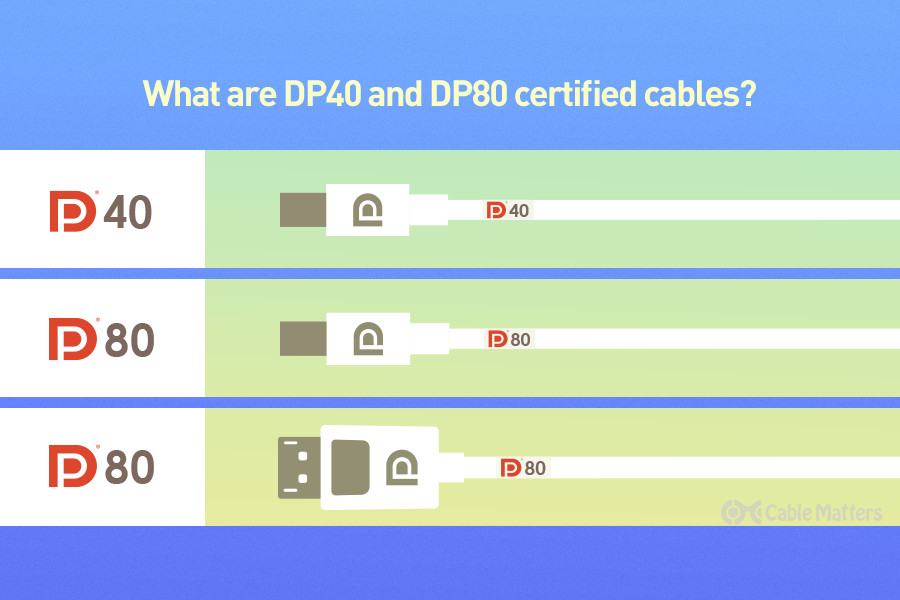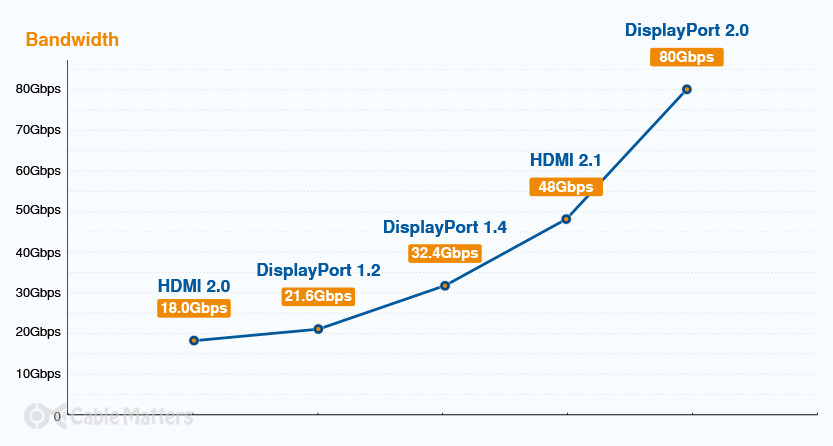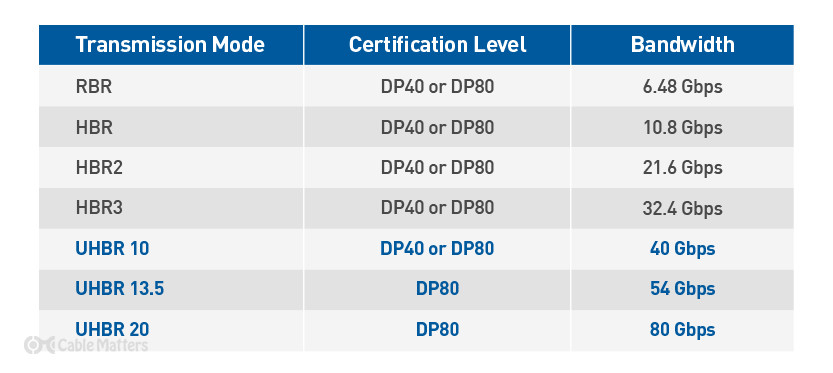
DisplayPort 2.0 is the next great advance in connection standards that will usher in a new age of high bandwidth transmission, enabling higher resolution video, higher refresh rates, and greater HDR detail than ever before. Not all DisplayPort 2.0 devices will be equal, though. As with previous generations of DisplayPort, DP 2.0 will feature a number of transmission modes with very different bandwidth capabilities. Only certain devices and certain DisplayPort cables will support the most capable transmission modes. To help explain those modes, there’s a new VESA certification system, too.
With the first DP 2.0 devices now certified and set to begin launching towards the end of the year, there’s no better time than to get acquainted with what the new connection standard has to offer.
Here’s everything you need to know about DisplayPort 2.0 certification.
What is DisplayPort 2.0?
DisplayPort 2.0 is the next evolution of the DisplayPort standard, coming after DisplayPort 1.4 and 1.4a. It is the first major change in the standard in six years, and ushers in a huge increase in bandwidth, new resolution and refresh rate support, new features, and improved support on different connectors.
DisplayPort 2.0 will use the same DisplayPort connector and port as previous DisplayPort standards, but will also be available over USB-C and Thunderbolt connections using DisplayPort Alt Mode over USB. Like DP Alt Mode on previous DisplayPort standards, this version allows the transmission of audio, video, and data over a single USB cable, allowing for simple connecting of supporting displays. This can be particularly useful when connecting external monitors to laptops with limited port options, and for daisy-chaining multiple monitors together.
[Read more about what DisplayPort 2.0 is here]
How fast is DisplayPort 2.0?

The standout feature of DisplayPort 2.0 is the major advances it makes in overall bandwidth. Where DisplayPort 1.4 offers a capable 32.4 Gbps maximum bandwidth (with a 25.92 Gbps maximum data rate due to encoding inefficiencies), DisplayPort has the option for more than double that. Its maximum total bandwidth is an astounding 80 Gbps (with a maximum total data rate of 77.37 Gbps).
This isn’t just much more than DisplayPort 1.4, it’s a huge leap over the current favorite high-end audio/video transmission protocol, HDMI 2.1. That can manage a mere 48 Gbps, with a maximum data rate of 42.6 Gbps.
The one caveat to this huge leap in performance is that not every DisplayPort 2.0 device, and DisplayPort 2.0 cable, will support the full bandwidth. DP 2.0 will come with support for seven different transmission modes, including three that are brand new for this generation of the standard.
It will support the previous four: Reduced Bit Rate (RBR), High Bit Rate (HBR), High Bit Rate 2 (HBR2), and High Bit Rate 3 (HBR3). Those were all present in DisplayPort 1.4, but DisplayPort 2.0 also introduces Ultra High Bit Rate 10 (UHBR 10), Ultra High Bit Rate 13.5 (UHBR 13.5), and Ultra High Bit Rate 20 (UHBR 20).
The new modes offer 10 Gigabits, 13.5 Gigabits, and 20 Gigabits per lane. With a standard DisplayPort 2 cable offering four lanes in each cable, the maximum bandwidth of the new modes will be 40 Gbps, 54 Gbps, and 80 Gbps, respectively, with a few gigabits per second shaved off to account for encoding inefficiencies (hence the lower overall max data rate for each transmission mode).
DisplayPort 2.0 Certification Explained
Not all DisplayPort 2.0 cables will support all of the new transmission modes, however, so some cables will only support UHBR 10, while others will support the full UHBR 20. This isn’t just confusing from a technical standpoint, it’s not a particularly clear terminology. Looking to fix that, the Video Electronics Standards Association, VESA, has certified two clear cable standards that you can look for when buying a DP 2.0 cable: DP40 and DP80.
But what is DP40, and what is DP80, when it comes down to it?
Cables certified DP40 will support everything up to and including the UHBR 10 transmission mode, giving it a maximum bandwidth of 40 Gbps. DP80 cables will support all seven DisplayPort transmission modes, including the highest bandwidth UHBR 13.5 and UHBR 20, giving it a maximum bandwidth of 80 Gbps.

DP40 Certified and DP80 Certified cables are already available in different shapes and sizes, some supporting the traditional DisplayPort connector, as well as others supporting the smaller mini DisplayPort standard. USB-C and Thunderbolt cables with DP40 and DP80 certification may also be released in due course.
In practice, the new DP40 and DP80 certified cables will offer support for higher resolutions and refresh rates than previous DisplayPort cables. DP40 Certified cables will be capable of transmitting up to uncompressed 4K video at 144Hz, or 8K at up to 30Hz. DP 80 certified cables will be able to support uncompressed 4K resolution at up to 240Hz, or 8K resolution at up to 85Hz.
One of the key features of DisplayPort 2.0 is its support of DSC 1.2a. This enables far greater resolution and refresh rate support, potentially unlocking the option of a single 16K display at 60Hz with HDR enabled, or three 10K displays at 60Hz.
When leveraging DP Alt Mode over USB-C for data and video transmission simultaneously, DP80 Certified cables should still be capable of outputting to three 4K displays at 144Hz with HDR with DSC enabled.
There are some DisplayPort 2.0 cables out there already, but official DP40 and DP80 Certified cables are much more limited in number and range. That’s due to them having to receive official VESA certification. They have to adhere to strict standards of quality and meet those minimum bandwidth capabilities in order to receive the DP40 and DP80 Certified status.
Cables that don’t have that certification may not be able to offer the same standards of physical quality and durability and are unlikely to be able to offer sustained performance in the higher transmission modes.
What Is The Best DisplayPort 2.0 Cable?
The best DisplayPort 2.0 cables will always be the ones with official VESA certification. By meeting VESA’s strict standards, they offer the highest quality cabling for excellent picture and audio quality without signal degradation, and you have that cast iron guarantee of them hitting their claimed bandwidth abilities. If you’re planning to push a DisplayPort 2 connection to its limits, running a 16K display, or multiple 8K monitors, that guarantee is important.
You can save money by going for non-DP40 and DP80 Certified cables, but there’s no guarantee they’ll be able to handle the resolutions you desire at favorable refresh rates.
When Will DisplayPort 2.0 Be Available?
New DisplayPort 2.0 cables are launching now, with many more cables going through the VESA certification program at the time of writing. Cable Matters plans to launch its line of certified DisplayPort 2.0 cables in September, so watch this space if you’re looking to equip your system or devices with a new DisplayPort 2.0 cable or two.
However, DisplayPort 2.0 compatible devices, systems, and displays are few and far between. That will change in the near future, though.
AMD recently announced that its upcoming generation of Ryzen 7000 processors and their compatible 600-series motherboards will all support a combination of four HDMI 2.1 and DisplayPort 2.0 ports. Those processors and motherboards are set to launch sometime in Q3 2022, so we’re mere months away from a range of compatible DIY home-built components and pre-built PCs hitting store shelves.
Likewise, AMD will launch its next-generation RDNA 3 graphics cards before the end of the year. With Ryzen 7000 processors supporting the new standard on the older RNDA 2 graphics architecture, it makes sense that RDNA 3 GPUs will launch with several DisplayPort 2.0 ports as standard.
Nvidia is set to debut its RTX 4000 Lovelace graphics cards at some point before the end of 2022 as well, so it seems only likely that those cards will also have support for DisplayPort 2, alongside HDMI 2.1. It’s not yet clear if some form of USB-C port will be present, however, as was the case with the older RTX 2000 series GPUs (though the feature was dropped from RTX 3000 cards).
With all of these systems, devices, and components with DisplayPort 2.0 support set to debut in the coming months, compatible displays will follow in due course. DisplayPort has traditionally been far more common on PC monitors than it has been on living room TVs, so DisplayPort 2 is likely to be the go-to connector for high-end computer monitors in the coming years.